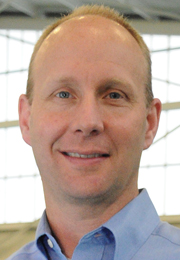School Wellness Education program looks to change behaviors, improve well-being

May 26, 2016
SLIPPERY ROCK, Pa. - Five years ago, faculty in Slippery Rock University's physical and health education department recognized a problem. The old "throw out the ball" approach to PE class just wasn't working any longer.
They set out to refocus their curriculum to meet the needs of today's society, particularly children in K-12, by focusing on movement and wellness as a means for preventing chronic health problems. Their work has paid off. Pennsylvania's State System of Higher Education authorized a program name change from Health and Physical Education: Teacher Education to School Wellness Education.
The revised program, which will launch in August, will prepare graduates to be certified to teach K-12 health and physical education with a health and wellness focus. Graduates will advocate the benefits of healthy living and be qualified to coordinate school-wide wellness initiatives, said Randy Nichols, professor of physical and health education.

NICHOLS
"Most people, when they think of health and physical education, develop a mental picture of someone wearing athletic shorts and a whistle around their neck," said Nichols. "They think more about a coach than they do a teacher. They associate the field more with sports than with health and wellness.
"Physical education has always been sports-oriented. There are a lot of sport and nonsensical games like dodge ball that give students no knowledge or skill to benefit them as a member of society.
"Elementary, middle and high schools need to be looked at as the epicenters for change. With that in mind, we knew we had to retool our message about health and physical education.
The revised program is about giving people the skills, knowledge and appreciation they need to be college, career and life ready in terms of health, wellness and physical activity, according to Nichols. "We're not about producing gym teachers, we're about producing school wellness educators and creating good behaviors."
The School Wellness Education program will base its curriculum on seven components of living well, including:
- Physical (activity and movement);
- Fueling your body (nutrition);
- Social and emotional wellness (strategies for managing stress, anxiety and depression);
- The human body (muscles, bones and organs);
- The human body response (benefits of wellness or consequences for lack of);
- Health-related fitness (training principles); and
- Injury prevention and wellness (self, others and environment)
The revised curriculum also includes activities that apply to a broader range of interests, including: dance, outdoor sports and net and wall games such as volleyball, squash and tennis.
"Our graduates will still teach what most people would think of as physical education, but with a completely different message," said Nichols. "Our mantra is to create a culture of health and wellness in schools, but not just in the gym or health class. We want teachers and students - when they open the door to the school - to see it and to feel it everyday."
When U.S. Surgeon General Vivek Murthy addressed a gathering at the Yale School of Public Health Sept. 17, 2015, he state that a "Golden Age" of public health was within reach, "an epoch marked by fairness and equality, where different sectors unite in the common cause of promoting health for all citizens.
"Public health is a key foundation for our country," Murthy said. "It is our collective responsibility to help the world understand this. We need young faculty and young students to step up and be part of this larger transformation in our country and around the world."
"Without it, the United States will not succeed in education, economic development or virtually any other endeavor."
Nichols concurs.
"We have an unhealthy society," he said. "Schools have a captive audience from the ages of 5-18. Those are incredibly formative years. During that time, we, as educators, need to worry less about changing behavior and more about creating behavior."
According to the U.S. Centers for Disease Control and Prevention, childhood obesity has more than doubled in children and quadrupled in adolescents in 30 years. The CDC said 7 percent of children, ages 6-11, were obese in 1980 compared to 18 percent in 2012. For children ages 12-19, obesity increased from 5 to 21 percent.
The CDC goes on to state that obese youth are more likely to be at risk of developing cardio vascular disease, high cholesterol, high blood pressure and pre-diabetes; and are at greater risk for bone and joint problems, sleep apnea and social and psychological problems such as poor self-esteem.
Nichols said all Americans should strive to move more, eat better, learn to control stress, anxiety and depression and get more sleep. "Schools, faith-based organizations and community centers are in a position to help advance that message," he added. "It is our goal to develop graduates that will carry those messages forward."
Inactive and unhealthy Americans don't just hurt themselves either. According to the Integrated Benefits Institute, a health research organization, poor worker health - as a result of underperformance due to bad health or absence due to illness - impacts U.S. productivity to the tune of $567 billion per year.
By fostering a healthy lifestyle as early as kindergarten, Nichols said, wellness could become ingrained as a core life value.
"The ability to learn is enhanced by physical activity and eating properly," Nichols said. "And how will students learn this? Through their wellness educators and classroom teachers."
Nichols estimates it could take up to 15 years for existing PE culture to change before students can fully benefit from the SWE approach.
"Teachers are not ready if we started our concept now," he says. "They understand it, but they don't know how to apply it."
But make no mistake; wellness educators will have their work cut out for them. On top of teaching health and wellness, they will also initiate and organize wellness programs that will involve a school wellness committee and classroom teachers, who will encourage and engage students in healthy movement during class time.
However, three local school districts are eager to try as interest in the program principles have already come from the Slippery Rock Area, Grove City Area and Central Valley school districts. To that end, Nichols and his staff are working with teachers in those districts to introduce the concept during daylong in-service sessions.
"Each of them are all in on the idea," Nichols said. "In fact, Slippery Rock is using their upcoming professional development days to learn and better understand the dynamics and interaction needed to make SWE work."
"At the end of the day, we have to think about health and what a child needs," Nichols said. "We are the people who can do it."
MEDIA CONTACT: Gordon Ovenshine | 724.738.4854 | gordon.ovenshine@sru.edu

